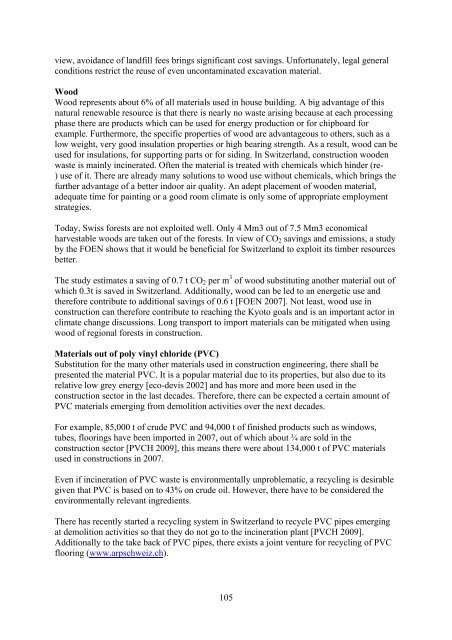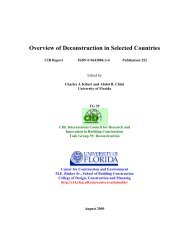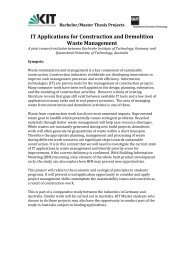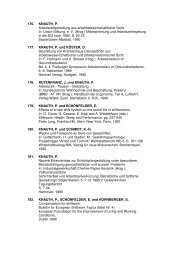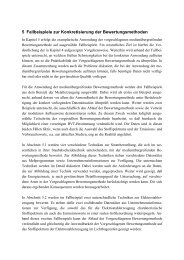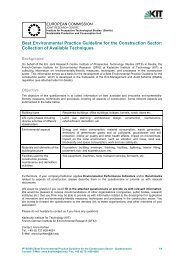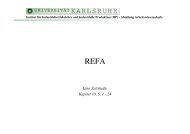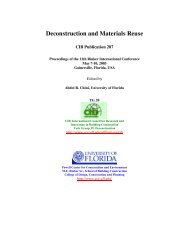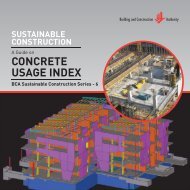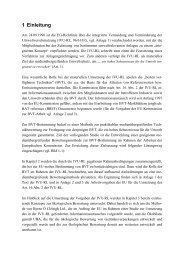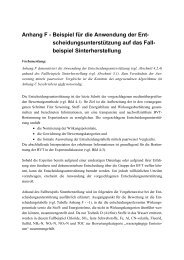Waste reduction final report -4 - Test Input
Waste reduction final report -4 - Test Input
Waste reduction final report -4 - Test Input
Create successful ePaper yourself
Turn your PDF publications into a flip-book with our unique Google optimized e-Paper software.
view, avoidance of landfill fees brings significant cost savings. Unfortunately, legal general<br />
conditions restrict the reuse of even uncontaminated excavation material.<br />
Wood<br />
Wood represents about 6% of all materials used in house building. A big advantage of this<br />
natural renewable resource is that there is nearly no waste arising because at each processing<br />
phase there are products which can be used for energy production or for chipboard for<br />
example. Furthermore, the specific properties of wood are advantageous to others, such as a<br />
low weight, very good insulation properties or high bearing strength. As a result, wood can be<br />
used for insulations, for supporting parts or for siding. In Switzerland, construction wooden<br />
waste is mainly incinerated. Often the material is treated with chemicals which hinder (re-<br />
) use of it. There are already many solutions to wood use without chemicals, which brings the<br />
further advantage of a better indoor air quality. An adept placement of wooden material,<br />
adequate time for painting or a good room climate is only some of appropriate employment<br />
strategies.<br />
Today, Swiss forests are not exploited well. Only 4 Mm3 out of 7.5 Mm3 economical<br />
harvestable woods are taken out of the forests. In view of CO 2 savings and emissions, a study<br />
by the FOEN shows that it would be beneficial for Switzerland to exploit its timber resources<br />
better.<br />
The study estimates a saving of 0.7 t CO 2 per m 3 of wood substituting another material out of<br />
which 0.3t is saved in Switzerland. Additionally, wood can be led to an energetic use and<br />
therefore contribute to additional savings of 0.6 t [FOEN 2007]. Not least, wood use in<br />
construction can therefore contribute to reaching the Kyoto goals and is an important actor in<br />
climate change discussions. Long transport to import materials can be mitigated when using<br />
wood of regional forests in construction.<br />
Materials out of poly vinyl chloride (PVC)<br />
Substitution for the many other materials used in construction engineering, there shall be<br />
presented the material PVC. It is a popular material due to its properties, but also due to its<br />
relative low grey energy [eco-devis 2002] and has more and more been used in the<br />
construction sector in the last decades. Therefore, there can be expected a certain amount of<br />
PVC materials emerging from demolition activities over the next decades.<br />
For example, 85,000 t of crude PVC and 94,000 t of finished products such as windows,<br />
tubes, floorings have been imported in 2007, out of which about ¾ are sold in the<br />
construction sector [PVCH 2009], this means there were about 134,000 t of PVC materials<br />
used in constructions in 2007.<br />
Even if incineration of PVC waste is environmentally unproblematic, a recycling is desirable<br />
given that PVC is based on to 43% on crude oil. However, there have to be considered the<br />
environmentally relevant ingredients.<br />
There has recently started a recycling system in Switzerland to recycle PVC pipes emerging<br />
at demolition activities so that they do not go to the incineration plant [PVCH 2009].<br />
Additionally to the take back of PVC pipes, there exists a joint venture for recycling of PVC<br />
flooring (www.arpschweiz.ch).<br />
105


